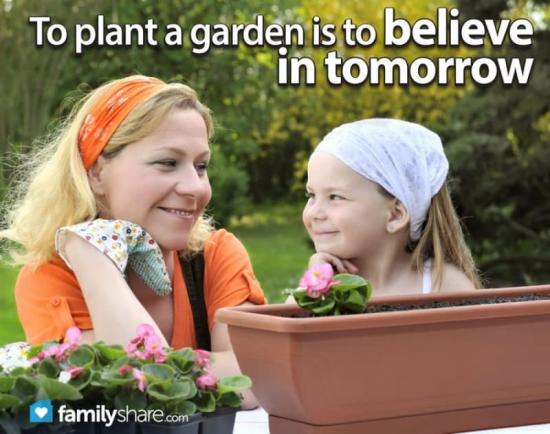
Gardening is good way to bring the family closer together while learning some basic life skills. As you share time together as a family you also teach your children to produce healthy food economically, how to work together, and to appreciate nature. If you don't have space for a traditional garden, you can plant in containers. Whether you only have room for a few pots inside or have a large yard, you can benefit from learning how to grow plants in containers. Containers add a new dimension to the garden whether flowers, vegetables or even a combination of the two.
There are certain things to consider when gardening in containers versus planting in the ground. Here are a few things to consider.
The container
The range of containers that can be used varies from small pots to large containers. Flowerpots, hanging baskets, planter boxes, livestock water troughs, to wooden containers are just a few examples of what can be used. A container gardener is limited only by the imagination. You can add color and texture as well as versatility of design.
The containers should be large enough to contain the plants you intend to put in them. A deep rooted plant needs a deep pot. Three plants in a pot require more room than one plant.
Smaller pots dry out more quickly as well as clay pots that allow moisture to evaporate through the sides. Containers that hold 15 quarts or more dry out slower.
If you live in a hot area or if your pot will be in direct sun for a lot of the day you will want a lighter colored pot. They don't absorb as much heat thus encouraging an even root growth, and decreasing evaporation.
Containers should be set on blocks or something similar to allow for proper drainage. The larger the container the more drainage holes are needed. Holes should be 1/2 inch across. Cover the holes with newspaper or coffee filters to prevent soil loss.
Plastic pots have a short life in sunlight. Wood rots except for redwood and cedar, which will last several years.
The growing medium
Garden soil is not recommended for containers because the particles are so small they compact and it doesn't drain well. Garden soil is also heavier to move around.
Growing medium should drain rapidly but hold enough moisture to keep the roots evenly moist. Commercial potting mixes are a favorite choice because they are lightweight and weed free.
When filling your container leave space at the top for a final layer of mulch. If the growing medium is not damp, add water and mix well before filling the container.
The soil you use is of major importance. A small, inexpensive plant in good soil has a world of potential while an expensive plant in poor soil has little future.
Water and fertilizer
Container plants lose moisture quickly. Some plants will need to be watered daily, especially during hot, dry weather. Stick your finger into the soil one inch deep to see if your pot needs water. If it is dry, it needs water. Give it a deep soaking. Don't over water.
Since frequent watering may leach nutrients from the soil, you may want to fertilize with a diluted liquid every other watering. Using an all-purpose blend of 3 parts Nitrogen: 1 part Phosphorous: 2 parts Potash (Potassium) is the average that plants actually use and is recommended. 24-8-16, 12-4-8, and 9-3-6 are all popular 3:1:2 ratios.
Pruning
Pruning dead limbs or limbs that cross and rub each other are essential to the health and beauty of your garden. Remove all spent flowers to encourage blooming. Clip back to the first leaves so you don't have unsightly bare stems. To make a plant more bushy, pinch the tips out of each branch.
Re-potting
Re-pot your plant if you see roots coming out the drainage holes. It is root bound. Gently tap the sides to loosen. Turn over and remove. Re-pot in a container that is only 1 or 2 inches larger than the one it is in. Add soil in the bottom then around the sides. Water it to settle the new soil.
Sunlight
Sunlight is as important as any of the above requirements but will depend on plant needs. Check to see how much sun your plants need and adjust the container's position so that it will be able to grow to its maximum potential.
Overwintering
Whenever possible move any plant that will not withstand frost inside near a window. If not possible or if you're using terracotta, pottery, or thin plastic containers, you can surround the pot with bubble wrap. Plants can be wrapped in burlap or something similar and covered with a tarp until the danger of frost is past. Whenever possible move to a protected area such as a garage.
If the plants have died, empty the pot, wash and dry, then store it.
Container gardening will allow your family to spend time together, produce food economically, learn the value of work, and connect with nature, even bringing it inside. It allows you to plan for tomorrow.
This is an excellent site for additional information on container gardening.

